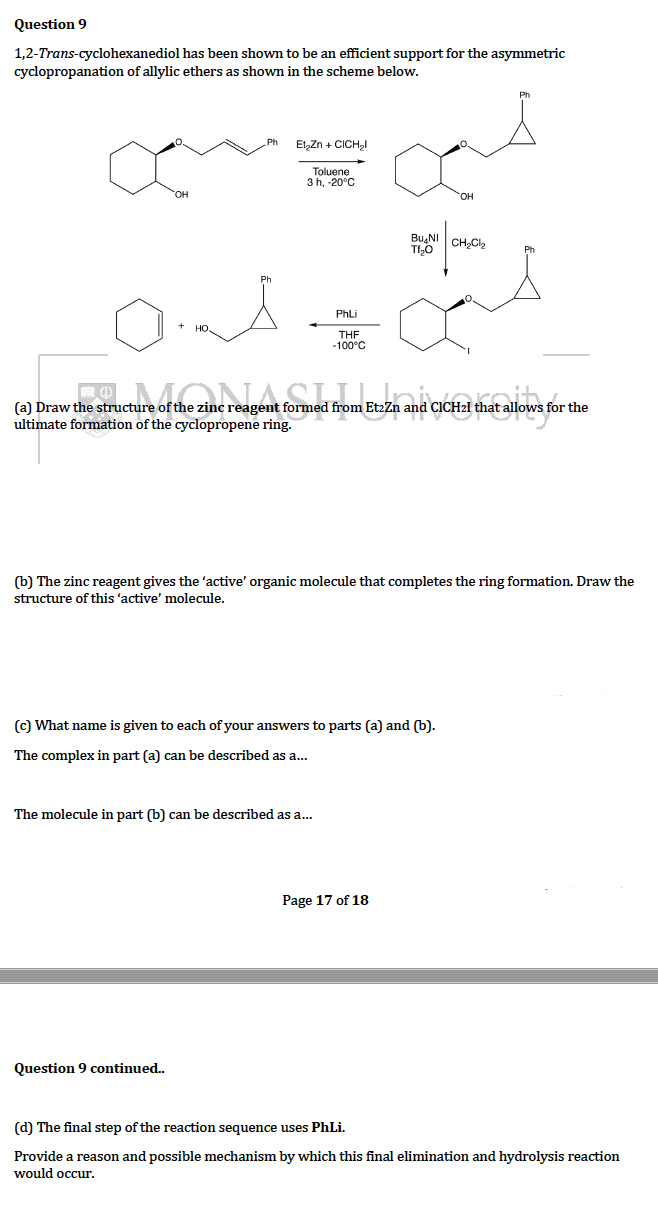Question 9 1,2-Trans-cyclohexanediol cyclopropanation of allylic ethers as shown in the scheme below. Ph Et₂Zn + CICH₂l Toluene 3 h, -20°C OH Ph and PhLi + НО THF -100°C (a) Draw the structure of the zinc reagent formed from Et2Zn the structure of the zinc reagent formed from Etz m ultimate formation of the cyclopropene ring. has been shown to be an efficient support for the asymmetric OH Bu₂NI TI₂O CH₂Cl₂ and CICH₂I that allows for the Et:Zn and CICH:I that allows f
Question 9 1,2-Trans-cyclohexanediol cyclopropanation of allylic ethers as shown in the scheme below. Ph Et₂Zn + CICH₂l Toluene 3 h, -20°C OH Ph and PhLi + НО THF -100°C (a) Draw the structure of the zinc reagent formed from Et2Zn the structure of the zinc reagent formed from Etz m ultimate formation of the cyclopropene ring. has been shown to be an efficient support for the asymmetric OH Bu₂NI TI₂O CH₂Cl₂ and CICH₂I that allows for the Et:Zn and CICH:I that allows f
Chapter18: Ethers And Epoxides; Thiols And Sulfides
Section18.SE: Something Extra
Problem 59GP: Meerwein's reagent, triethyloxonium tetrafluoroborate, is a powerful ethylating agent that converts...
Related questions
Question
100%
Need help with part a). Thank you :)

Transcribed Image Text:Question 9
has been shown to be an efficient support for the asymmetric
1,2-Trans-cyclohexanediol
cyclopropanation of allylic ethers as shown in the scheme below.
Et₂Zn + CICH₂l
Toluene
3 h, -20°C
Bu NI
TI₂O
CH₂Cl₂
and=a
PhLi
THF
-100°C
(a) Draw the structure of the zinc reagent formed from EtzZn and CICHal that allows for the
ultimate formation of the cyclopropene ring.
(b) The zinc reagent gives the 'active' organic molecule that completes the ring formation. Draw the
structure of this 'active' molecule.
(c) What name is given to each of your answers to parts (a) and (b).
The complex in part (a) can be described as a...
The molecule in part (b) can be described as a...
Page 17 of 18
Question 9 continued..
(d) The final step of the reaction sequence uses PhLi.
Provide a reason and possible mechanism by which this final elimination and hydrolysis reaction
would occur.
Expert Solution
This question has been solved!
Explore an expertly crafted, step-by-step solution for a thorough understanding of key concepts.
Step by step
Solved in 2 steps with 1 images

Knowledge Booster
Learn more about
Need a deep-dive on the concept behind this application? Look no further. Learn more about this topic, chemistry and related others by exploring similar questions and additional content below.Recommended textbooks for you


Organic Chemistry
Chemistry
ISBN:
9781305580350
Author:
William H. Brown, Brent L. Iverson, Eric Anslyn, Christopher S. Foote
Publisher:
Cengage Learning

EBK A SMALL SCALE APPROACH TO ORGANIC L
Chemistry
ISBN:
9781305446021
Author:
Lampman
Publisher:
CENGAGE LEARNING - CONSIGNMENT


Organic Chemistry
Chemistry
ISBN:
9781305580350
Author:
William H. Brown, Brent L. Iverson, Eric Anslyn, Christopher S. Foote
Publisher:
Cengage Learning

EBK A SMALL SCALE APPROACH TO ORGANIC L
Chemistry
ISBN:
9781305446021
Author:
Lampman
Publisher:
CENGAGE LEARNING - CONSIGNMENT

Organic Chemistry: A Guided Inquiry
Chemistry
ISBN:
9780618974122
Author:
Andrei Straumanis
Publisher:
Cengage Learning